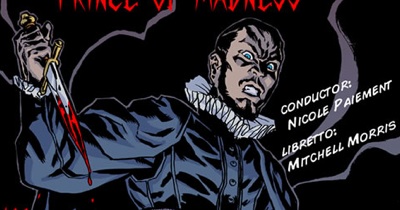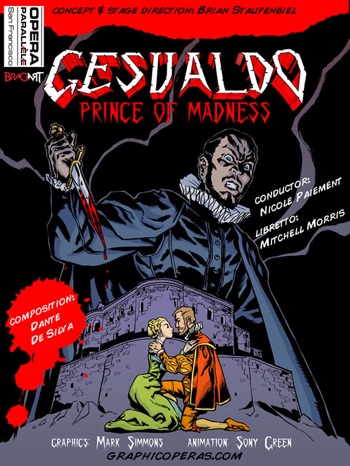
Madness in the madrigal form…
San Francisco’s ever-adventurous Opera Parallèle staged a working reading of Dante da Silva’s Gesualdo, Prince of Madness last Friday, June 7 at the SF Conservatory of Music. While the creative team of Brian Staufenbiel and conductor Nicole Paiement specialize in contemporary opera, this is their first commission, and, not surprisingly, it included an experimental backdrop that could shift our perception of the genre.
An actual historic figure from the sixteenth century, Carlo Gesualdo was a composer and Italian prince who murdered his wife and her lover after discovering them together. Although he was above the law due to his station, it is thought that his guilt eventually drove him to madness (he did have a retainer whip him every day!).
What makes him especially interesting to composers is the combination of his instability and the intense chromaticism of his sacred writing and madrigals. His floating keys and dissonant beauty are more reminiscent of the late nineteenth century, and of Schoenberg’s later forays into tonal hinterlands.
LA composer Dante de Silva dished up ancient modal and modern rock rhythms, but kept returning to a core trio of female voices, a faithful rendering of Gesualdo’s harmonic experiments and the tonal center of the opera. Sung by Sarah Eve Brand, Lora Libby and Rachel Rush, their three lines were enchanting. When not doing madrigals, the three accented Gesualdo’s text, repeating his self-absorbed torments in three part harmonies.
For this first run-through, Keisuke Nakagoshi built the backbone on piano, with Eva-Maria Zimmerman using electronic filters on keyboard to add wind and string instruments (and giving us a sense of the finished sound). Those two artists are also the four-hands piano duo that comprises ZOFO, perhaps adding to the seamlessness of this work-in-progress. McKenzie Camp rendered a forest of colorings with percussion, and interludes were filled with arpeggios and flourishes by Adam Cockerham on theorbo, the long-necked lute of the Renaissance. That ancient sound was surprisingly clear amid piano and percussion, and a lovely fit for the vocal lines (and probably tuned up a quarter step to fit the modern piano).
As the lights darkened, comic-book frames appeared on the back wall, our story line in pen and ink with masses of shadow and highlight. Like Lichtenstein’s huge canvases, this art form has an overblown iconography, one that fits well with the melodrama of traditional opera. Particularly, the love and murder scenes were as “graphic” as any operagoer could wish for, a testament to artist Mark Simmons. Having them loom as the set and supertitles over a row of singers and their music stands was so perfectly disconcerting that a polished performance would be beside the point.
I know of no other opera company that could workshop this into such style, with a frenzied last week of rewriting parts and inking cels, and with singers and instrumentalists sight-reading the changes.
Despite the power of the performance, with the buttery-tongued Daniel Cilli in the title role, there was a moral disconnect for me. Part of that disconnect may be the long search for justice, with a final scene inferring mixed messages of forgiveness and/or poisoning of Gesualdo by his second wife (excellently sung by coloratura soprano Maya Kherani).
…and sanctioned madness.
Or the whole wife-as-possession may be getting a little old. In the stabbing scene, as the animated knife moved up and down, and he stabbed her over and over, I kept thinking about a young friend who was stabbed to death by her ex-boyfriend last winter, and I can no longer find the stabbing of women as “artful.” Two hundred years before Gesualdo, Dante Alighieri wrote about his aunt, Francesca da Rimini, and her lover, Paolo, also stabbed to death by her husband. But in Dante’s Inferno the torments of Hell clearly awaited that earthly depravity.

So what has changed since the Renaissance? Last week I was in Ashland for the Oregon Shakespeare Festival, and saw Streetcar Named Desire. It starred a brilliant Stanley… who rapes his sister-in-law and then forces her into an asylum. I could also have seen Taming of the Shrew, a time-honored Shakespeare vehicle about the selling and breaking of a strong-willed daughter. Or I could have seen My Fair Lady, which adds the insults of class to the process of making a young woman saleable for a high bid.
Sadly, not much has changed since the sixteenth century, and there has even been a resurgence of interest into the life of Gesualdo, a perfectly lovely composer… who additionally murdered his baby son for fear that he wasn’t the father! If this survives to the larger Opera Houses, should ladies wear sequined gowns on opening night? Or just cover themselves completely in burkas?
—Adam Broner
Poster of “Gesualdo,” courtesy of Opera Parallèle.
